IN THIS ISSUE
- Wildlife trail upgrades
- Rare find for rare mussels
- Add fall color to your yard
- Survey and DNR cap giveaway
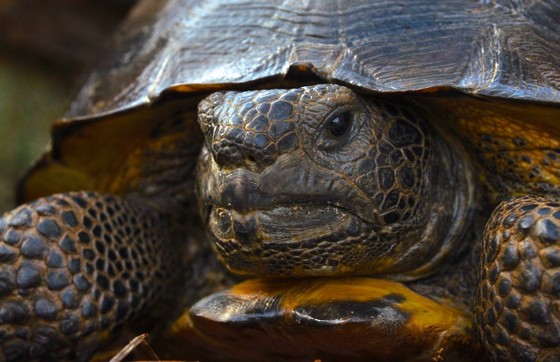 Gopher tortoise (Mark Krist)
Tax changes included in the pandemic-focused CARES Act offer new incentives for donations to nonprofits. But only in 2020.
Benefits are available for individual and corporate donors. Consult a tax professional for details.
Donations to the Georgia Wildlife Conservation Fund are deductible to the extent allowed by law. Contributions are critical to restoring and protecting Georgia’s rare and other wildlife not legally fished for or hunted – from bald eagles to gopher tortoises – plus rare plant species and natural habitats.
This work is led by Georgia DNR’s Wildlife Conservation Section, which depends largely on fundraisers, donations and federal grants.
For more on donating, including to the section’s friends group TERN and the Georgia Natural Resources Foundation, visit georgiawildlife.com/donations.
Top
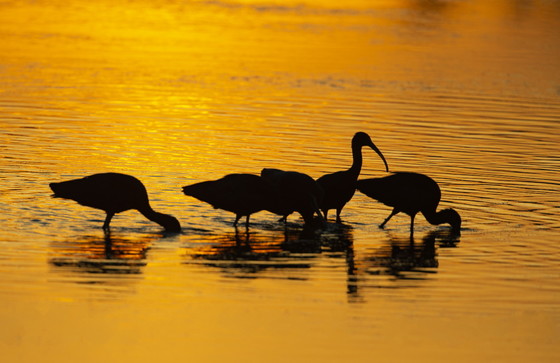 White ibis at sunset on Altamaha WMA (Ty Ivey/GNPA)
Exploring wildlife and history on Georgia’s coast is easier and more engaging thanks to a new website and app features announced this week by DNR.
Creating georgiabirdingtrails.com and adding a trail function to the Go Outdoors Georgia app are part of DNR Wildlife Resources Division efforts to expand its Georgia Birding and Wildlife Trails program.
The upgrades offer improved accessibility to wildlife viewing resources and support Georgia’s $2 billion-a-year interest in birding and other wildlife watching.
The first trail updated is Georgia’s oldest. Created in 1999, the Colonial Coast Birding Trail links 17 birding and wildlife hotspots from Fort Pulaski in Savannah to Cumberland Island off St. Marys. These federal, state and local sites provide rich opportunities to see wildlife, connect with nature and experience coastal history.
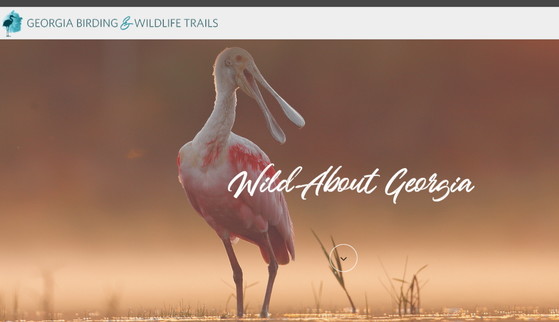 LEARN MORE
Top
 Though small in size, the juvie mussels (far left, compared to adults on right) are big finds. (Matt Rowe/DNR)
Good news for rare freshwater mussels is, well, rare.
But one south Georgia creek is providing some.
While checking a football field-long stretch of a Lee County stream last month, a DNR crew found scores of endangered mussels and – even better – a double-handful of juveniles for two federally listed species.
This Flint River tributary north of Albany has proven a mother lode for mussel diversity since DNR began monitoring it after 2007, when record drought parched the Southeast. The latest from the mark/recapture project yielded 1,235 mussels – extending exponential increases since 2017 – and site highs for Gulf moccasinshells (171), oval pigtoes (64) and shinyrayed pocketbooks (seven).
“Most heartening,” added DNR aquatic biologist Matt Rowe, “were the numbers of young juveniles.”
Juvie mussels are hard to find because they’re so small and researchers are usually searching for them blind, gently “raccooning” the stream bottom by hand. The discovery of nine young Gulf moccasinshells and one oval pigtoe shows indicates reproduction and “a very positive trend in this population,” Rowe said.
Georgia ranks among the top five states in mussel species. But more than a quarter of those species are critically imperiled. Beyond functions such as filtering water, anchoring stream sediments and doubling as prey, mussels serve as freshwater’s canary in the coal mine. Limited in movement and dependent on stable habitats, mussels by their presence or absence reveal the health of stream systems.
The Lee County creek, one of five long-term monitoring sites in the Flint River basin, features forested banks, a protective tree canopy and sufficient flows. All are factors that have helped create a bright spot for mussels.
Where mussels are concerned, “usually, we get excited about anything positive we run across," Rowe said. “The major threat to mussels is habitat disturbance, and we just don’t have that many places that haven’t been disturbed.”
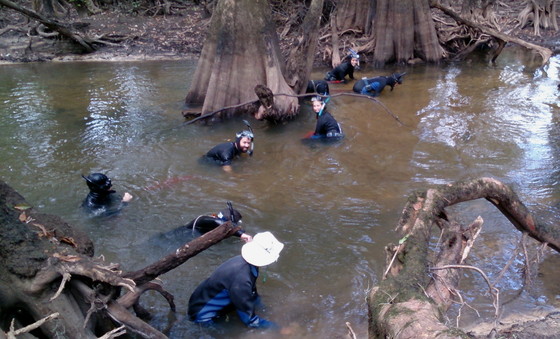 Surveying for mussels in a south Georgia creek (DNR)
IF YOU’RE WONDERING
Researchers most often find juvenile mussels by the strong, elastic byssal threads these mini-mollusks secrete and use to help move and anchor themselves.
“You’re running your hands through the substrate and the threads get wrapped around your fingers,” DNR's Matt Rowe said.
Juvie mussels range from 6-10 millimeters, or about a quarter to a third of an inch. Any younger and smaller, and researchers can’t tell the species, Rowe said.
Top
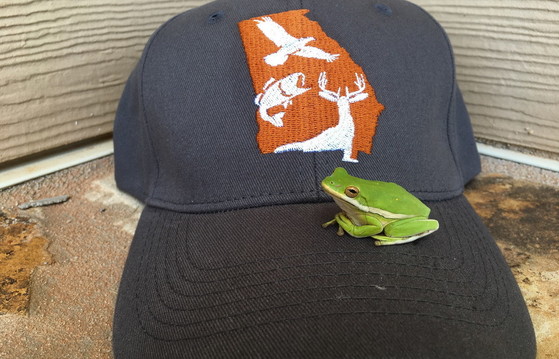 Back by popular demand, it’s the annual Georgia Wild reader survey.
OK, the survey is actually back by DNR demand. That’s because this short questionnaire provides needed insights into how well we’re communicating conservation to readers.
We value your feedback so much, we’re sweetening the pot again this year.
Click the button below, complete the survey, add your email and you’ll be entered in a drawing for one of 10 Wildlife Resources Division caps (treefrog not included).
But do it soon. The survey closes Sept. 30. Winners will be notified by Oct. 6.
Top
 Sassafras leaves in autumn (Terry W. Johnson)
By TERRY W. JOHNSON
While many of us don’t live in north Georgia, we all know that seeing the best fall color in the state requires a trip to the mountains.
However, while there is no question the trip is worth it, did you know you can create a fall foliage show at home?
Obviously, your yard will lack the panoramic scope of the extravaganza that blankets the mountains and valleys of our northernmost counties. But it can feature many of the same breathtaking colors. Here’s how …
Read Terry’s recommendations for fall favorites to consider adding to your yard.
Terry W. Johnson is a retired DNR program manager and executive director of TERN, the Wildlife Conservation Section’s friends group. Check out past columns, his Backyard Wildlife Connection blog and his book “A Journey of Discovery: Monroe County Outdoors.” His columns are also featured on DNR’s blog, under the Conservation tab. Permission is required to reprint any of Terry’s columns.
Top
 High five for prescribed fire: Shan Cammack and Burner Bob (Randy Tate/Longleaf Alliance)
DNR’s Shan Cammack will receive the Burner Bob Prescribed Fire Champion award at the Longleaf Alliance’s virtual Biennial Longleaf Conference Oct. 20-23. The senior wildlife biologist and Wildlife Conservation Section fire management officer is a high-energy ambassador for prescribed fire, promoting it through outreach, leadership, training and work in the field, including in this award-winning video of Burner Bob. Cammack said many others had a hand in the effort culminating in the award named for the prescribed fire mascot: “I guess it takes a village to raise a giant bobwhite quail!”
The Georgia Prescribed Fire Council will move its annual conference online to showcase new perspectives and the latest wildland fire research. The Zoom meeting set for 10 a.m.-3 p.m. Sept. 30 will include clips from Gov. Brian Kemp and U.S. Agriculture Secretary Sonny Perdue.
CoastFest, the popular Brunswick celebration of coastal wildlife and habitats, is also going virtual. The DNR Coastal Resources Division is providing live YouTube sessions Sept. 30-Oct. 2, videos on manatee rescues and other topics, CoastFest's art and a new essay contest, and T-shirts.
Top
 Monarch butterfly on milkweed (Linda May/DNR)
An Atlanta-based effort to provide and restore needed habitat for butterflies, bees and other pollinators has expanded statewide. Previously the Greater Atlanta Pollinator Partnership, the new Georgia Pollinator Partnership, or GAPP, is urging residents to register their pollinator gardens at gapp.org and help develop an interactive map for conservation partners to chart pollinator resources.
Despite the pandemic, the 2020 Great Georgia Pollinator Census racked up some impressive stats Aug. 21-22. According to UGA’s Center for Urban Agriculture, 3,755 people took part, documenting almost 83,000 insect “visits,” representing 124 of the state's 159 counties and creating 525 pollinator spaces, or plots.
With the Great American Outdoors Act signed into law, support is building for a second piece of federal legislation considered critical to wildlife conservation. The infrastructure-centered Moving Forward Act (HR 2) passed by the House and awaiting action in the Senate encompasses Recovering America’s Wildlife Act, which would help states and tribal agencies conserve more than 12,000 at-risk species, creating up to 33,500 jobs a year and turn a $1.4 billion investment into a $3.3 billion economic impact. Learn more.
Top
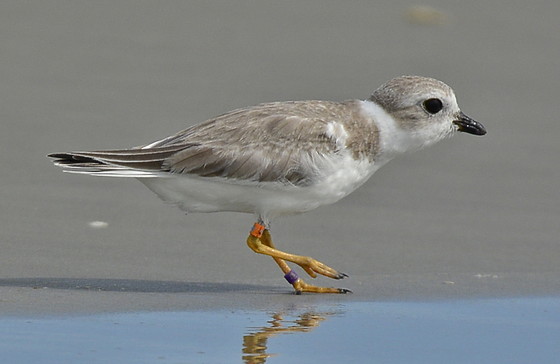 Piping plover "Hazel" on Cumberland Island (Doris and Pat Leary)
Two of the bird world’s youngest rock stars were turning heads on the Georgia coast last month. The piping plovers – one seen on Cumberland Island, the other on Little Egg Island Bar – are members of an endangered plover population and siblings from a headline-making clutch raised in Chicago this summer. The third fledgling from that nest also migrated south and was seen in Sarasota, Fla., Sept. 1.
Tegu sightings are on the rise in South Carolina. After alerting the public about finding an Argentine black and white tegu in the wild, state biologists fielded a flurry of reports and confirmed eight more sightings, raising fears the invasive South American lizards are more widespread in the Palmetto State than known.
Hunters and others outdoors in southeast Georgia’s Tattnall and Toombs counties are urged to report sightings of tegus, dead or alive. DNR is working with the U.S. Geological Society and Georgia Southern University to assess and eradicate a wild population of the big reptiles, which threaten native wildlife.
Top
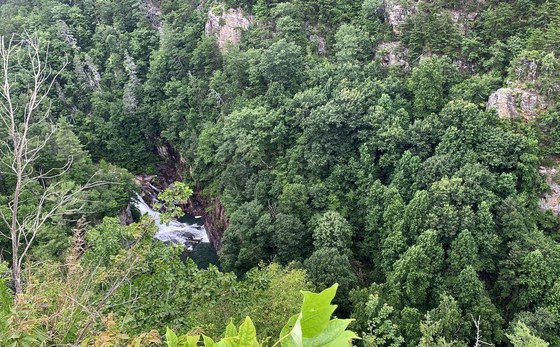 Survey finds surviving Tallulah Gorge hemlocks responding to woolly adelgid treatment (Carlee Steppe/DNR)
The first survey of eastern hemlocks treated in 2017-2018 for hemlock woolly adelgid at Tallulah Gorge State Park yielded encouraging results. Despite suffering high mortality rates from the invasive insects, many surviving hemlocks “seem to be bouncing back,” writes DNR botanist Carlee Steppe, who checked the trees with Atlanta Botanical Garden’s Carrie Radcliffe.
St. Simons Land Trust celebrated its 20th year in fitting fashion last month. The organization formed to preserve St. Simons' natural and scenic qualities was reaccredited by the national Land Trust Alliance and announced the acquisition of 3 forested, marsh-front acres on Kings Way, an island gateway.
DNR winners at this year's conference of the Association of Conservation Information, the national group for natural resource communicators, included this newsletter (first in the External Newsletter category), the Return to River Creek story map about red-cockaded woodpeckers (first in Wildlife Article), Burner Bob (second in Education) and a wildlife license plates ad (third in Posters).
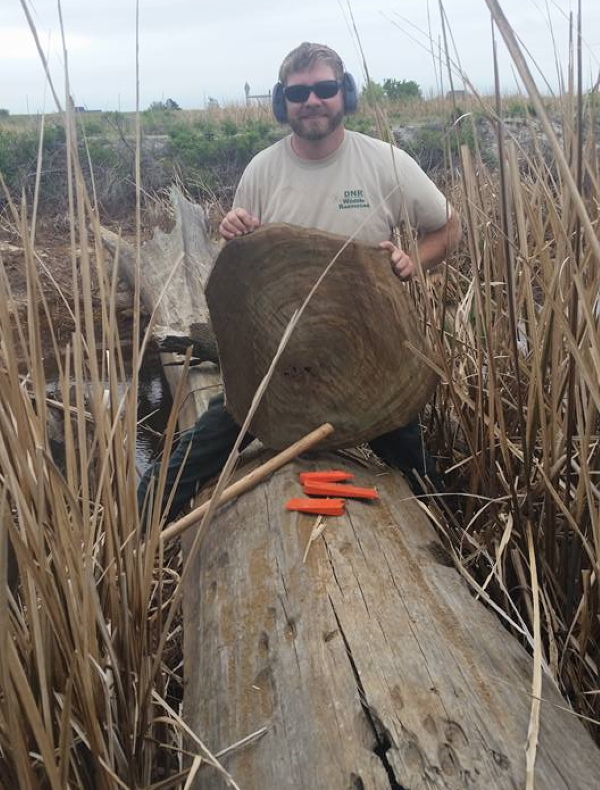
A UGA doctoral student’s study of tree rings in ancient, dead bald cypress at Altamaha Wildlife Management Area is detailing 5,000 years of climatic change on the Georgia coast. Kat Napora’s deep dive into dendrochronology also involved DNR’s Robert Horan (right) and Craig Jacobs chainsawing slices called “cookies” from the trees, many of which were buried in mud.
While hatching continues, the last sea turtle nest deposited in Georgia – Aug. 25 on Wassaw Island – capped a solid season for loggerheads. The Sea Turtle Cooperative documented 2,775 nests, shy of 2019’s record 3,950 nests but strong for what was predicted as a low year and more support for the trend that shows loggerhead nesting increasing on average nearly 4 percent a year.
A fourth hibernaculum for federally endangered Indiana bats has been found in Alabama. The Shelby County cave is the state’s largest concentration and the continent's most southern hibernation site for the species. The first Southeastern bat in the U.S. with white-nose syndrome had also been reported from the site, but according to later analysis that bat was misidentified: It was likely an Indiana.
|
Names in the news: DNR Capt. Stan Elrod was laid to rest in Toccoa Sept. 8. The 28-year Law Enforcement Division veteran and supervisor of DNR’s Gainesville-based Region 2 was exercising along a road near his Danielsville home when he was hit by a driver now facing vehicular homicide, DUI and other charges. Georgia Forestry Commission Deputy Director Gary White has been named the agency’s interim director following the departure of former Director Chuck Williams. Hall County Game Warden Ryan Locke is DNR’s Game Warden of the Year. Game Warden Dean Gibson, assigned to Talbot County, received the James R. Darnell Award as runner-up. The Georgia Natural Resources Foundation Board announced Lyndy Saparow as its new executive director. University of Florida graduate student Sydney Williams received a National Estuarine Research Reserve System Margaret Davidson Graduate Fellowship to fund her research on Sapelo Island into how water quality changes threaten the health of coastal ecosystems. U.S. Fish and Wildlife Service retired special agent Tom Chisdock has been presented the Guy Bradley Award, which honors “outstanding lifetime contributions” to wildlife law enforcement. Georgia Audubon hired Corina Newsome, an organizer of #BlackBirdersWeek, as its community engagement manager and Sergio Sabat-Bonilla as a Coastal Sea Grant Fellow, a partnership with the Jekyll Island Authority and Georgia Sea Grant.
WHAT YOU MISSED ...
In the previous Georgia Wild:
- Trapping tegus
- Experiences with fire
- The go-to grape for wildlife
- Looking for rare moths
- Endangered dropwort's big year
Top
 "Sea Turtle Boil" (hatchlings emerging), The Lodge on Little St. Simons Island
"Hey, Whaddaya Know? Garter Snakes," DNR
"Great Horned Owl Transfers Prey to Potential Mate," Landings Bird Cam/Cornell Lab of Ornithology
2020 Georgia Youth Birding Competition T-shirt Art entries: High School Division, Middle School, Elementary, Primary. DNR
"A World without Sea Turtles," Conservancy of Southwest Florida
"Clybel Grasshopper Invasion," DNR
"Explore! Pennsylvania State Amphibian: Eastern Hellbender," Pennsylvania Historical and Museum Commission
"Waterspout in Brunswick River," DNR Coastal Resources Division
Top
"Bat woman works to save environment" (DNR's Emily Ferrall), Enjoy! Cherokee Magazine
(+audio) "Another good year for sea turtle nesting," WABE-FM (90.1, Atlanta)
(+video) "DOT discovers rare plants ahead of road project," WCTV-TV (Ch. 2, Tallahassee, Fla.)
"Vessel strikes and a dead calf," Right Whale News
"Court allows lobstering to continue as whale rules written," News Center Maine
"Georgia takes steps to save 'little things that run the world,'" SaportaReport. Also: "Mapping pollinator habitats goes statewide," AllonGeorgia.
"Inside Florida's alleged flying squirrel smuggling operation," National Geographic
"Gopher tortoise translocations (to St. Catherines) deemed 'remarkable success,'" The Wildlife Society. Study in Journal of Wildlife Management.
"To save Appalachia’s mussels, scientists hatched bold plan," Science News
"Natural Georgia: Ceylon newest WMA," Savannah Morning News
"Racism, harassment common in field research, scientists say," Nature
(+audio) "How Georgia protected its salt marsh 50 years ago," WABE-FM (90.1, Atlanta)
"New theme for home school curriculum at Charlie Elliott," Chattanoogan.com
"Crime ring trafficking in shark fins dismantled, U.S. says," The New York Times
"Gator hunting in the Southeast," U.S. Fish and Wildlife Service
"California looks to battle mega wildfires with fire," Scientific American. Related: "They know how to prevent megafires: Why won't anybody listen?" ProPublica.
"Chattahoochee River proposal calls for 100-mile trail," Reporter newspapers
"Gators may be able to survive venomous snake bites," Discover. Study in Journal of Herpetology.
"Noise pollution preventing whales from contacting each other," One Green Planet
"AI model developed to identify individual birds without tagging," The Guardian
"Living Planet Report 2020," World Wildlife Fund
Top
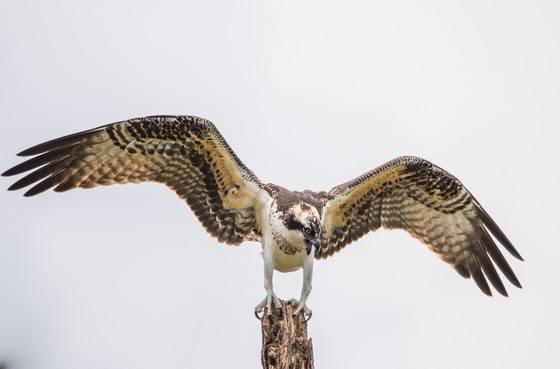 This immature osprey appeared to be practicing landings on a precarious perch at Lake Allatoona, writes photographer Ron Goldfarb, who watched the bird light on the snag a number of times.
CREDITS
Masthead: belted kingfisher (Ty Ivey/GNPA)
Robert Horan holds a slice sawn from an ancient cypress (Kat Napora/UGA)
Loggerhead sea turtle hatchling on Little St. Simons Island (Sarah Martin/DNR)
Top
|